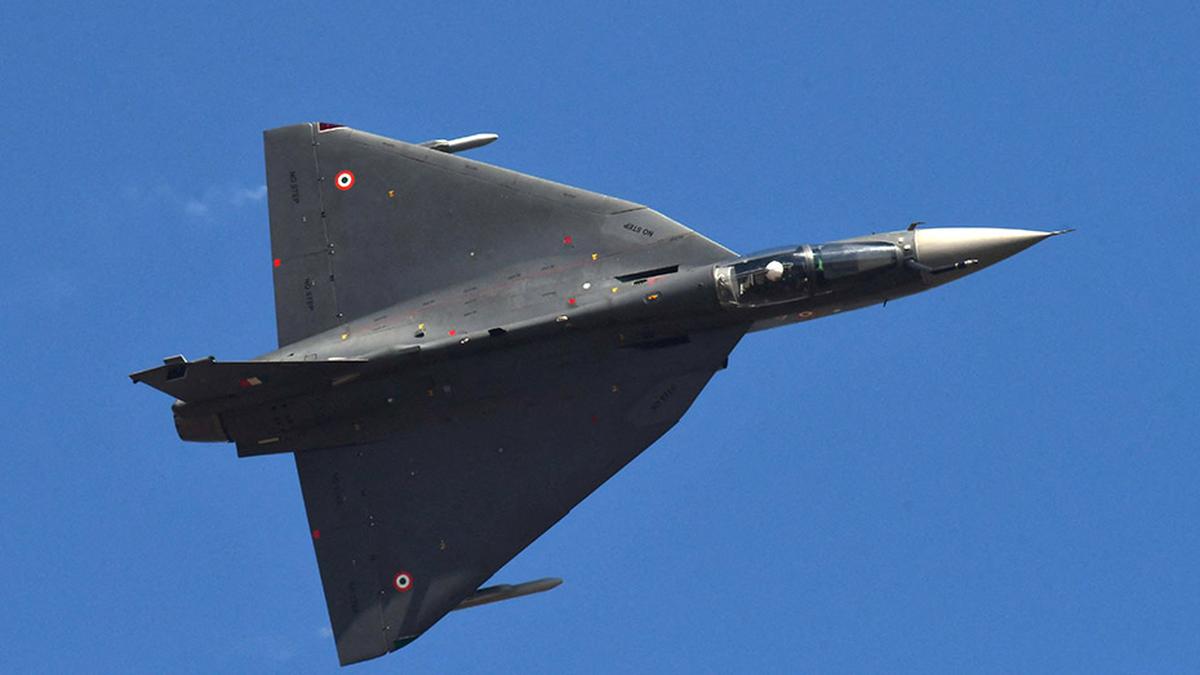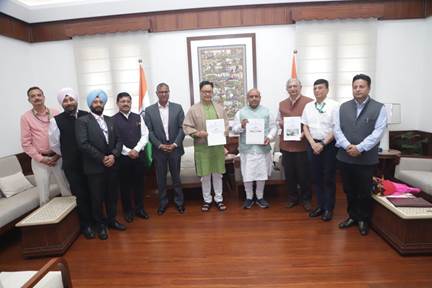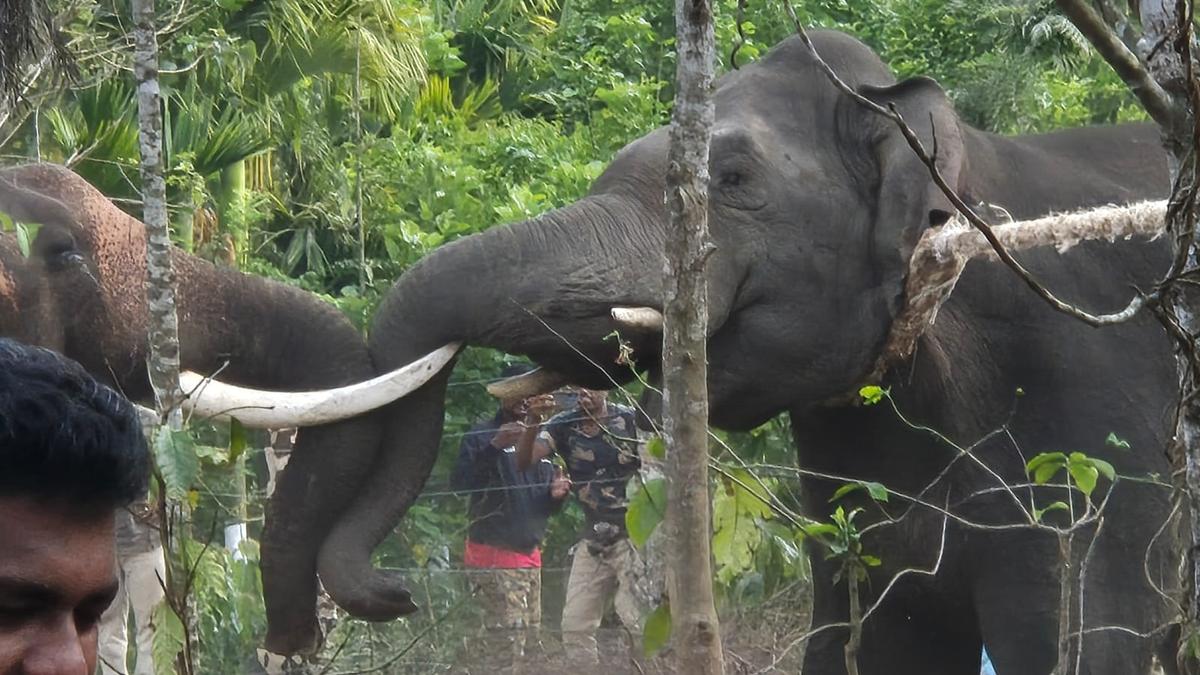Tejas LCA Mk1A

- 29 Mar 2025
In News:
GE Aerospace has commenced delivery of F404-IN20 jet engines to Hindustan Aeronautics Limited (HAL) for the Tejas Light Combat Aircraft Mk1A. This marks a significant milestone in India’s indigenous defence production capabilities and is vital for bridging the Indian Air Force's (IAF) operational gaps.
Background on Tejas LCA Mk1A
- Tejas LCA Mk1A is an advanced version of the indigenous Light Combat Aircraft (LCA) developed by HAL.
- It incorporates over 40 improvements over the Mk1 variant, aimed at enhancing combat readiness, survivability, and ease of maintenance.
Key Features:
- Radar Systems:
- Israeli EL/M-2052 AESA Radar.
- Indigenous Uttam AESA Radar (under integration).
- Electronic Warfare:
- Unified Electronic Warfare Suite (UEWS).
- Advanced Self-Protection Jammer Pod.
- Weapons Capability:Nine hardpoints supporting Beyond Visual Range (BVR) missiles, Air-to-Air and Air-to-Ground missiles, and Advanced Short-Range Air-to-Air Missiles (ASRAAM).
- Digital Fly-by-Wire System:Upgraded Flight Control Computer (DFCC Mk1A).
- Improved Operational Efficiency:Reduced weight, enhanced maintainability, and faster sortie turnaround.
Engine Deliveries and Production Status
- First Engine Delivered: March 26, 2025; expected in India by April.
- Engine Type: F404-IN20 by GE Aerospace – a high-thrust variant tailored for IAF needs.
- Key Engine Features:
- Higher-flow fan, single-crystal turbine blades, and customized components.
- Achieved Mach 1.1 during Tejas’ maiden flight in 2008.
Delivery Commitments:
- 2025 Target: 12 engines and 12 Tejas Mk1A jets to be delivered.
- Full Order: 99 engines ordered in 2021.
- Production Goal: HAL to produce 24 aircraft per year.
- Current Readiness: Three Mk1A jets flying; 11 more expected by end-2025 (10 from Bengaluru, 1 from Nasik).
Production Challenges:
- Engine production was dormant for five years.
- Reinitiating during the COVID-19 pandemic caused further delays.
- GE has now stabilized its supply chain and resumed engine production.
Strategic Importance for IAF
- Current IAF Strength: 31 fighter squadrons (sanctioned strength: 42.5).
- Urgency: Older aircraft like Jaguar, MiG-29UPG, and Mirage-2000 will begin phasing out by decade-end.
- Future Platforms: LCA Mk2 is under development; AMCA (Advanced Medium Combat Aircraft), India’s 5th-gen stealth fighter, is still a decade away.
Policy Push:A high-level committee led by the Defence Secretary submitted recommendations to the Defence Minister for enhancing IAF capabilities in short, medium, and long-term.
Lyme Disease
- 29 Mar 2025
In News:
Lyme disease, also known as Lyme borreliosis, is a bacterial infection caused by Borrelia burgdorferi. It is transmitted to humans through the bite of infected blacklegged ticks, commonly known as deer ticks. These ticks become carriers when they feed on infected animals, such as rodents. Importantly, Lyme disease does not spread from person to person, nor through food, water, air, pets, or other insects like mosquitoes and flies.
The disease is primarily reported in North America, Europe, and parts of Asia, particularly in wooded and grassy regions during the warmer months. In the United States, it is most prevalent in the northeastern, mid-Atlantic, and upper Midwestern states.
Symptoms and Progression
Lyme disease often begins with a characteristic red, expanding rash called erythema migrans, which may appear in a bull’s-eye pattern. Early symptoms also include fever, chills, fatigue, muscle aches, headache, and swollen lymph nodes. If untreated, it can progress to cause:
- Neurological issues: meningitis, facial palsy (Bell’s palsy), nerve pain, and brain inflammation.
- Cardiovascular problems: irregular heartbeat and heart block.
- Musculoskeletal symptoms: arthritis, joint pain (especially in the knees), and swelling.
- Other effects: dizziness, vision problems, memory issues, and concentration difficulties (often referred to as “brain fog”).
Treatment Protocol
Lyme disease is primarily treated with antibiotics, especially when diagnosed early. Common antibiotics include doxycycline (for adults and children over 8 years), amoxicillin (for younger children and pregnant women), cefuroxime, and azithromycin (for those allergic to other options). The treatment duration varies:
- Localized skin infections: 14 days
- Early disseminated infections: 21 days
- Lyme arthritis: 28 to 60 days
- Severe or neurological cases may require intravenous antibiotics like ceftriaxone
In some cases, symptoms may persist even after treatment, a condition known as Post-Treatment Lyme Disease Syndrome (PTLDS). While the exact cause is unknown, continued antibiotic use does not improve outcomes, and treatment focuses on managing symptoms.
Recent Scientific Breakthrough
In a major scientific advancement, researchers have identified a crucial enzyme—lactate dehydrogenase specific to Borrelia burgdorferi (BbLDH)—which plays a vital role in the bacterium's survival and infectivity. Unlike most organisms that rely on thiamin-dependent metabolism, B. burgdorferi uniquely depends on BbLDH to convert pyruvate to lactate, maintaining its NADH/NAD+ balance.
The research, conducted at Virginia Commonwealth University and published in mBio, demonstrated through genetic, biochemical, and structural analysis that BbLDH is essential for the growth and infection capability of the Lyme disease bacterium. Loss-of-function studies confirmed its indispensability, both in laboratory and in vivo models.
High-throughput screening of chemical compounds led to the identification of several promising BbLDH inhibitors. These inhibitors could form the basis for future, highly targeted treatments against Lyme disease. Moreover, the findings have broader implications for tackling other tick-borne illnesses.
Delhi Joins National e-Vidhan Application (NeVA)

- 29 Mar 2025
In News:
The Delhi Legislative Assembly has become the 28th legislature in India to sign a tripartite Memorandum of Understanding (MoU) with the Ministry of Parliamentary Affairs (MoPA) and the Government of NCT of Delhi for implementing the National e-Vidhan Application (NeVA). This move marks a significant advancement in India's push for paperless, transparent, and efficient legislative processes.
About NeVA:
- Developed by: Ministry of Parliamentary Affairs
- Hosted on:Meghraj 2.0, India’s national cloud infrastructure
- Objective: To digitize legislative operations across State Legislatures and Union Territory Assemblies
- Vision: Aligned with the “One Nation, One Application” initiative
Key Features:
Feature Description
Device-Neutral Accessible via smartphones, tablets, laptops, and desktops
Real-Time Access Legislators can view agendas, bills, questions, committee reports, and proceedings anytime
Digital Repository Secure storage for legislative documents with confidentiality and integrity
Multilingual Support Facilitates linguistic inclusivity across India
Member-Centric Tools Access to member directories, notices, starred/unstarred Q&A, digital bulletins, and
house business
Public Interface Allows citizens and media to access legislative documents and updates
Smart Legislative Tools Aids Speakers/Chairs in conducting proceedings smoothly
Stakeholders Benefiting from NeVA:
- Members of Legislative Assemblies and Councils
- Government Ministers and Department Staff
- Assembly Secretariat Officials
- Media and General Public
Delhi’s Onboarding Highlights:
- Signed By: Ministry of Parliamentary Affairs, Delhi Legislative Assembly, and GNCTD
- Purpose: To empower Delhi MLAs with digital tools and reduce paper-based procedures
- Significance: Part of Delhi’s 100-day governance agenda aimed at modernization and transparency
Coeliac Disease
- 29 Mar 2025
In News:
Recent advancements in artificial intelligence (AI) may significantly accelerate the diagnosis of coeliac disease, an inherited autoimmune disorder triggered by gluten consumption. Researchers at the University of Cambridge have developed an AI-based tool capable of diagnosing the disease swiftly and accurately, potentially transforming current diagnostic practices.
What is Coeliac Disease?
- Nature: An inherited autoimmune disorder.
- Cause: Triggered by consumption of gluten, a protein found in wheat, barley, and rye.
- Mechanism: Gluten intake causes an immune reaction in the small intestine, damaging the intestinal lining (villi), leading to malabsorption of nutrients.
Key Symptoms:
- Gastrointestinal: Diarrhoea, bloating, stomach cramps, weight loss
- Systemic: Fatigue, anaemia, skin rashes
- In children: Impaired growth and development
- Long-term complications: Malnutrition, osteoporosis, infertility, anaemia, and increased risk of autoimmune diseases and certain cancers
Prevalence and Risk Factors:
- Affects approximately 1 in 100 people worldwide
- About 700,000 people in the UK live with the disease
- Individuals with a first-degree relative (parent, sibling, or child) with coeliac disease have a 1 in 10 risk
- It can develop at any age after gluten consumption begins
Diagnosis and Treatment:
- Current Diagnostic Method:
- Blood tests to detect gluten antibodies
- Duodenal biopsy to assess damage to villi (requires analysis by pathologists)
- Treatment: No cure; managed through a strict lifelong gluten-free diet
AI-Based Diagnostic Advancement:
- Development: By University of Cambridge researchers
- Function: The AI model analyses biopsy images to detect villous damage
- Training: Based on 4,000+ biopsy images from five hospitals using scanners from four manufacturers
- Efficiency: Matches the accuracy of expert pathologists, with diagnosis in under a minute
- Impact: Could eliminate delays caused by backlog in pathology labs and speed up diagnosis for patients
Significance of AI in Healthcare:
- Benefits:
- Faster diagnosis for patients
- Reduces burden on pathologists and NHS waiting lists
- Frees up time for pathologists to focus on more critical cases (e.g., cancer)
- Expert Support:Recognised by the Royal College of Pathologists as a tool with the potential to transform diagnostic pathology
- Future Requirements:
- Investment in digital pathology
- Integrated IT systems across health organisations
- Training for medical professionals in AI-based diagnostic tools
Bhadra Wildlife Sanctuary

- 29 Mar 2025
In News:
Karnataka Forest Department has initiated a "soft release" strategy to address the escalating human-elephant conflict in the districts of Hassan, Chikkamagaluru, and Kodagu. The strategy involves the phased rehabilitation of captured elephants into the Bhadra Wildlife Sanctuary (BWS).
Soft Release Strategy – Key Highlights
- Objective: To rehabilitate conflict-prone wild elephants and reduce human-elephant encounters.
- Implementation Site:Bhadra Wildlife Sanctuary (BWS), Chikkamagaluru district.
- Initial Step: Captured elephants will be placed in a 20 sq. km enclosure within the sanctuary.
- Purpose of Enclosure:
- Acclimatisation to the wild.
- Health monitoring and behavioural assessment.
- Final Release: Once deemed fit, elephants will be released into one of four pre-identified zones in BWS, chosen based on:
- Availability of water and forage.
- Absence of human activity.
- Road connectivity.
Monitoring & Management
- The enclosure will be fenced using railway barricades.
- A dedicated team of veterinarians will supervise the elephants from a nearby veterinary centre.
- Minimal human interaction will be ensured during the acclimatisation period.
- Expert guidance is being provided by Prof. R. Sukumar (Indian Institute of Science) and senior forest officials.
About Bhadra Wildlife Sanctuary (BWS)
- Location: Western Ghats, Karnataka.
- Area: 492.30 sq. km.
- Also Known As:Muthodi Wildlife Sanctuary.
- Named After: Bhadra River.
- Status: A designated Project Tiger Reserve.
Ecological Significance
- Forest Types:
- Southern Moist Mixed Deciduous Forests.
- Dry Deciduous Forests.
- Shola Forests.
- Wildlife Diversity:
- Mammals: Tigers, leopards, elephants, gaurs, dholes, and deer.
- Birds: ~250 species, including endemic birds like Hornbills, Malabar Trogon, and Hill Myna.
Significance of the Initiative
- Biodiversity Conservation: Enhances protection of endangered species and habitats in the Western Ghats.
- Conflict Mitigation: Aims to provide a sustainable solution to frequent elephant incursions, crop damage, and human casualties.
- Model Strategy: Draws upon similar practices implemented in West Bengal and tailors them to Karnataka’s ecological conditions.
